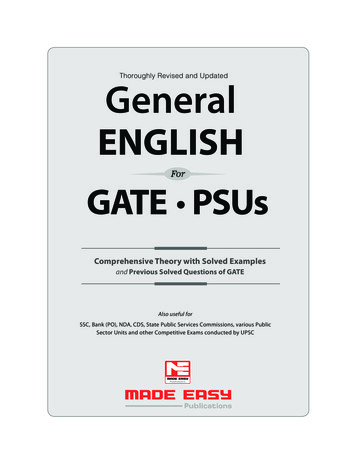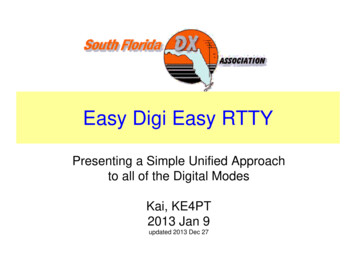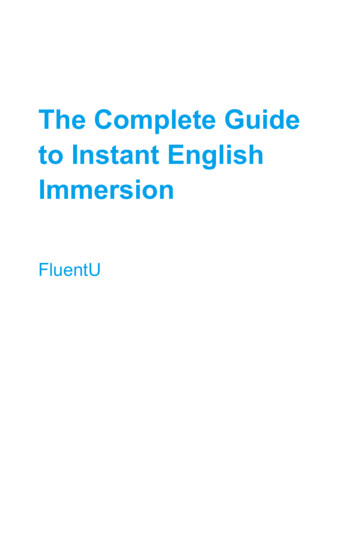
Transcription
Thoroughly Revised and UpdatedGeneralENGLISHForGATE PSUsComprehensive Theory with Solved Examplesand Previous Solved Questions of GATEAlso useful forSSC, Bank (PO), NDA, CDS, State Public Services Commissions, various PublicSector Units and other Competitive Exams conducted by UPSCPublications
PublicationsMADE EASY PublicationsCorporate Office: 44-A/4, Kalu Sarai, New Delhi-16; Noida Office: D-28, Sector-63, Noida, U.P.Website: www.madeeasypublications.org; Phone: 011-45124660, 0-8860378007E-mail: infomep@madeeasy.inGeneral English Copyright by MADE EASY Publications.All rights are reserved. No part of this publication may be reproduced, stored in or introduced intoa retrieval system, or transmitted in any form or by any means (electronic, mechanical, photocopying, recording or otherwise), without the prior written permission of the above mentionedpublisher of this book.1st Edition : 20082nd Edition : 20113rd Edition : 2012Re-print : 20134th Edition: 20145th Edition: 20156th Edition: 20167th Edition: 20178th Edition: 20189th Edition: 2019MADE EASY PUBLICATIONS has taken due care in collecting the data and providing the solutions, beforepublishing this book. Inspite of this, if any inaccuracy or printing error occurs then MADE EASY PUBLICATIONSowes no responsibility. We will be grateful if you could point out any such error. Your suggestions will be appreciated.
PrefaceThe General English Section is an important section of GATE and various PSUs’ entrance tests. The book isdesigned to test the candidate’s understanding of English and workmanlike use of words. It is unique inthe way that it provides concrete content review for the test as well as strategies for tackling the trickyquestions.Features of this book : Strategies and tricks on how to understand evaluate and manipulate Comprehension Passagesand Vocabulary. You’ll be able to articulate the passage in your own words. Techniques to eliminate 3 wrong choices confidently even if you can’t fully comprehend a questionor a passage. Gist of ten types of grammar errors and help you develop a strong sense of both grammar and theconventions of English language. Keywords searching tips to find what you need to look for when you are answering the questions.You will not waste time re-reading the whole passage. Techniques to locate facts, trace an author’sline of logic, and map the structure of a passage. This book briefs you on the different aspects of Grammar, Vocabulary-in-context and Readingcomprehension questions giving you key tips on how to tackle these important types ofquestions. Made Easy book on General English offers you enough material for a year-long study program aswell as for a short duration preparation module so that you don’t have to settle for last-minutecram sessions. Pace yourself as you work your way through the wealth of practice exercisesdesigned for you. It contains high-frequency word list, incorporating vocabulary from various exam of last 10 years’papers. Practice questions with explained answers to prepare you for the spotting the errors, sentencecompletion and reading comprehension questions. Practice exercises have been organizedaccording to level of difficulty with dozens of clear, helpful pointers and several new questionsmodelled closely on questions appearing in various exams. MADE EASY Book on General English takes you through the very basics of General English to thetoughest questions that might be tested in GATE and PSUs papers.This latest edition of Made Easy Book on General English is a sign of MadeEasy’s on-going commitmentto make this book India’s outstanding guide for various competitive exams. It has benefited from thededicated labours of the editorial staff of Made Easy, and from the research and writing skills of ourauthors. We are greatly indebted to them.We wish you all the best for your preparation!!!
How to use this book?1.The book is divided in Units which deal with particular problems coming underone category so start your preparation in the same order.2.Every Section has been divided into Chapters covering different topics from thatparticular segment.3.Once you have completed a particular chapter; do the practice exercises given init and then take the tests. Analyse your score and re-read the questions that youwent wrong with.4.Once you have completed all the units and feel confident about taking modelpapers then you can confidently attempt the five mock papers provided at theend of the book.5.Take full advantage of the questions from the previous years papers which havebeen discussed in every chapter. Understand the paper pattern and trends ofexam.6.Once again revise the fundamentals before your exam.mmmm
ContentsSection 1 : Spotting Errors & Sentence CorrectionChapter 1 : Introduction to English Grammar.14Chapter 2 : Basics of English Grammar.17Chapter 3 : Subject Verb Agreement.19Chapter 4 : Verbs & Tenses.28Chapter 5 : Conditional Sentences.44Chapter 6 : Direct & Indirect Speech.46Chapter 7 : Active-Passive Voice.52Chapter 8 : Modifiers.62Chapter 9 : Pronoun Agreement.65Chapter 10 : Idioms & Phrasal Verbs .69Chapter 11 : Prepositions.81Chapter 12 : Articles.84Chapter 13 : Practice Questions .88Section 2 : VocabularyChapter 14: Vocabulary .97Chapter 15: Approaches of learning words & their retention.98Chapter 16: Antonyms. 139Chapter 17: Synonyms. 146Chapter 18: Sentence Completion. 154Chapter 19: Paronyms and Homonyms. 173Chapter 20: Practice Questions. 179Section 3 : Critical ReasoningChapter 21: Introduction to Critical Reasoning. 188Chapter 22: Types of Arguments. 191Chapter 23: Five Strategies for Critical Reasoning. 193Chapter 24: Types of Questions in Critical Reasoning and Approaches. 194Chapter 25: Critical Reasoning: Tips & Tricks. 200Chapter 26: Practice Exercise. 201Section 4 : Previous GATE Solved QuestionsPrevious Years GATE Solved Questions. 222
Orientation to Verbal Ability Sectionof GATE & PSUsThe verbal ability section of the GATE is designedto test a candidate’s ability to reason with wordsin solving problems. Reasoning effectively in averbal medium depends primarily upon the abilityto discern, comprehend, and analyse relationshipsamong words or groups of words and within largerunits of discourse such as sentences and criticalreasoning arguments.The verbal ability of the GATE usually consists of fourquestion types: Analogies, Antonyms/ Synonyms,Sentence Completion, and Critical Reasoning.The conceptual framework along with the practicequestions which have been provided in every chapterof this book are organized by content category andrepresent the types of questions included in GATE.The purpose of these questions is to provide someindication of the range of topics covered in the testas well as to provide some additional questions forpractice purposes.AnalogiesAnalogy questions test the ability of the candidateto recognize the relationship that exists between thewords in a word pair and to recognize when two wordpairs display parallel relationships. To answer ananalogy question, you must formulate the relationshipbetween the words in the given word pair and thenmust identify the answer choice containing words thatare related to one another in most nearly the sameway. Some examples of relationships that might befound in analogy questions are relationships of kind,size, spatial contiguity, or degree.Approaches for answering Analogy Questions: Before looking at the answer choices, try toestablish a precise relationship between the wordsin the given pair. It is usually helpful to expressthat relationship in a phrase or sentence. Next, look for the answer choice with the pairof words whose relationship is closest to thatof the given pair and can be expressed in asimilar fashion. Occasionally, more than one of the answerchoices may seem at first to express arelationship similar to that of the given pair. Try tostate the relationship more precisely or identifysome aspect of the relationship between thegiven pair of words that is paralleled in only onechoice pair.Remember that a single word can have severaldifferent meanings. Check to be sure you havenot overlooked a possible second meaning forone of the words.Never decide on the best answer withoutreading all the answer choices.Practice recognizing and formulating relationships between word pairs. You can do this withthe following sample questions.Sample QuestionsDirections: The question below consists of a pairof related words followed by four pairs of words.Select the pair that best expresses the relation inthe original pair.1.COLOR: SPECTRUM(a) Tone: Scale(b) Sound: Waves(c) Verse: Poem(d) Dimension: SpaceSolution: The relationship between color andspectrum is not merely that of part to whole, in whichcase (c) might be defended as correct. A spectrum ismade up of a progressive, graduated series of colors,as a scale is of a progressive, graduated sequenceof tones. Thus, (a) is the correct answer choice. Inthis instance, the best answer must be selected froma group of fairly close choices.2.HEADLONG: FORETHOUGHT(a) Barefaced: Shame(b) Mealy-mouthed: Talent(c) Heartbroken: Emotion(d) Level-headed: ResolveSolution: The difficulty of this question probablyderives primarily from the complexity of the
MADE EASY General English8relationship between headlong and forethought ratherthan from any inherent difficulty in the words. Analysisof the relationship between headlong and forethoughtreveals the following: an action or behaviour that isheadlong is one that lacks forethought. Only answerchoice (A) displays the same relationship betweenits two terms. Synonyms / AntonymsAlthough synonym / antonym questions testknowledge of vocabulary more directly than do anyof the other verbal question types, the purpose ofthe synonym / antonym questions is to measure notmerely the strength of your vocabulary but also theability to reason from a given concept to its opposite.Synonyms / Antonyms may require only rathergeneral knowledge of a word, or they may requireyou to make fine distinctions among answer choices.Synonyms / Antonyms are generally confined tonouns, verbs, and adjectives; answer choices maybe single words or phrases.Approaches for answering Synonym / Antonymquestions: Remember that you are looking for the wordthat is the most nearly similar / opposite to thegiven word; since many words do not have aprecise synonym / opposite, you must look forthe answer choice that expresses a conceptmost nearly same / opposite to that of the givenword. In some cases more than one of the answerchoices may appear at first to be similar /opposite to the given word. Questions thatrequire you to make fine distinctions among twoor more answer choices are best handled bydefining more precisely or in greater detail themeaning of the given word. It is often useful, in weighing answer choices,to make up a sentence using the given wordor words. Substituting the answer choices inthe phrase or sentence and seeing which best“fits,” in that, may help you determine the bestanswer. Remember that a particular word may havemore than one meaning. Use your knowledge of root, prefix, and suffixmeanings to help you determine the meaningsof words with which you are not entirely familiar. The practice questions will help you preparefor your test in many ways. First, completingthe practice exercises will make you familiar with the question format. They will also get youthinking of words in terms of other words withsimilar or opposite meanings.For example, a word may be familiar to you—you may have seen it in print and have a generalsense of what it means—but when tested, youmay discover that you do not know the word’sprecise meaning. These exercises will helpyou pinpoint those familiar words for which youneed to learn the exact definition. In addition,you will probably encounter words that aretotally unfamiliar.By memorizing their definitions, you can addthese words to your vocabulary and call uponthem at test time to improve your score.Third, many of the questions in your AptitudeTest of GATE test your ability to discern nuancesof meaning. The question may ask you toidentify the synonym for a secondary definitionof a common word—for example, “inclinationor natural ability’’ is a secondary definition ofthe word “bent.’’ Also, the direction for theseexercises usually ask you to identify the wordthat is “most similar’’ or “most dissimilar’’ inmeaning to the word in the question. This meansthat you may be asked to pick between degreesof meaning. For example, “atrocious’’ means“utterly revolting’’; in this case, “revolting’’ wouldbe a more accurate synonym than “unpleasant’’Make a list of all the words that you missed andtheir definitions. Then study this list as a quickand concentrated method to improve yourvocabulary. In some cases, you will also benefitfrom looking up the definitions of the wordsthat you selected incorrectly to ensure that youknow the precise meaning of these words. Thenadd these words to your study list as well.Sample QuestionsDirections: Each question below consists of a wordprinted in capital letters followed by five letteredwords or phrases. Choose the lettered word orphrase that is most nearly opposite in meaning to theword in capital letters. Since some of the questionsrequire you to distinguish fine shades of meaning,be sure to consider all the choices before decidingwhich one is best.1.DIFFUSE(a) Contend(b) Concentrate(c) Imply(d) Pretend
MADE EASY General EnglishSolution: The best answer is (b). Diffuse means topermit or cause to spread out; only (b) presents anidea that is in any way opposite to diffuse.2.MULTIFARIOUS(a) Deprived of freedom(b) Deprived of comfort(c) Lacking space(d) Lacking diversitySolution: Multifarious means having or occurring ingreat variety, so the best answer is (d). Even if you arenot entirely familiar with the meaning of multifarious,it is possible to use the clue provided by “multi-” tohelp find the right answer to this questionSentence CompletionThe purpose of the sentence completion questions isto measure the ability to use the various kinds ofcues provided by syntax and grammar to recognizethe overall meaning of a sentence. In decidingwhich of five words or sets of words can best besubstituted for blank spaces in a sentence, you mustanalyse the relationships among the componentparts of the incomplete sentence. You must considereach answer choice and decide which completesthe sentence in such a way that the sentence hasa logically satisfying meaning and can be read as astylistically integrated whole.Sentence completion questions provide a contextwithin which to analyse the function of words as theyrelate to and combine with one another to form ameaningful unit of discourse.Approaches for answering Sentence CompletionQuestions: Read the entire incomplete sentence carefullybefore you consider the answer choices. Besure you understand the ideas expressed andexamine the sentence for possible indicationsof tone (irony, humour, etc.) Before reading the answer choices, you mayfind it helpful to fill in the blanks with a word orwords of your own that complete the meaningof the sentence. Then examine the answerchoices to see if any of them parallels your owncompletion of the sentence. Pay attention to grammatical clues in thesentence. For example, words like although andnevertheless indicate that some qualificationor opposition is taking place in the sentence,9 whereas moreover implies an intensification orsupport of some idea in the sentence.If a sentence has two blanks, be sure thatboth parts of your answer choice fit logicallyand stylistically into the sentence.When you have chosen an answer, read thecomplete sentence through to check that it hasacquired a logically and stylistically satisfyingmeaningSample QuestionsDirections: Each sentence below has one or twoblanks, each blank indicating that something hasbeen omitted. Beneath the sentence are five letteredwords or sets of words. Choose the word or set ofwords for each blank that best fits the meaning of thesentence as a whole.1.Early ------- of hearing loss is ------- by the factthat the other senses are able to compensatefor moderate amounts of loss, so that peoplefrequently do not know that their hearing isimperfect.(a) Discovery . Indicated(b) Development . Prevented(c) Detection . Complicated(d) Treatment . FacilitatedSolution: The statement that the other sensescompensate for partial loss of hearing indicatesthat the hearing loss is not prevented or corrected;therefore, choice (b) can be eliminated. Furthermore,the ability to compensate for hearing loss certainlydoes not facilitate the early treatment (d) or theearly discovery (A) of hearing loss. It is reasonable;however, that early detection of hearing loss iscomplicated by the ability to compensate for it. Thebest answer is (c).2.The ------- science of seismology has grownjust enough so that the first overly bold theorieshave been -------.(a) Magnetic . Accepted(b) Fledgling . Refuted(c) Tentative . Analysed(d) Predictive . ProtectedSolution: At first reading, there may appear to bemore than one answer choice that “makes sense”when substituted in the blanks of the sentence. (a),(c), and (d) can be dismissed fairly readily when it isseen that accepted, tentative, and protected are notcompatible with overly bold in the sentence.
MADE EASY General English10Critical ReasoningCritical Reasoning questions are designed to gaugeyour ability to think critically and analytically — morespecifically: To recognize reasoning errors and unstatedassumptions To follow an argument’s line of reasoning To draw reasonable inferences from statedpremisesEach Critical Reasoning question provides aparagraph-length argument, along with a questionpertaining to that argument. Each question willrequire you to perform one of the following seventasks:1.Recognizing how to undermine (weaken) anargument. (“Which of the following, if true, wouldmost seriously weaken the argument above?”)2.Recognizing how to support (strengthen) anargument. (“Which of the following, if true,would provide most support for the conclusionof the argument above?”)3.Identifying unstated assumptions. (“Theforegoing argument depends on which of thefollowing assumptions?”)4.Drawing an inference from a series of statedpremises. (“If all of the statements above aretrue, which of the following is most stronglysupported by them?”)5.Making valid deductions based on a seriesof premises and/or a conclusion. (“If all ofthe statements above are true, which of thefollowing must also be true?”) (“Which of thefollowing statements must be true in order forthe conclusion in the argument above to beinferable?”)6.Recognizing patterns of reasoning. (“Whichof the following demonstrates a pattern of7.8.reasoning most similar to the reasoningcontained in the argument above?”) (“Theflawed reasoning above is most similar to theflaw in which of the following?”)Recognizing the main point, or final conclusion,of an argument. (“Which of the following bestexpresses the main point of the passageabove?”)The best approach to the question oftendepends on the question type. Thus youshould always read the question before readingthe argument, so that you know how to thinkabout the argument as you read it. On the otherhand, you won’t gain any insight by readingthe answer choices beforehand; you’ll just bewasting precious time by doing so.6-Step Approach for Critical ReasoningQuestionsThe 6-step approach for handling any unstatedassumption, undermining-evidence, or supportingevidence question is as follows:1.Read the question stem (the question itself,but not the answer choices) before you readthe argument.2.As you read the argument, identify thepremises and the conclusion. Doing so willhelp you follow the argument’s line of reasoning.Keep in mind that the conclusion will not alwaysappear last.Look at this example:During the past year consumers have clearlybecome less concerned about their health andlevel of fitness. After all, during the past yearnationwide membership in fitness clubs hasdeclined by about fifteen percent, while sales offast-food products widely known to contributeto health problems, have risen by about thesame percent.3.Ask yourself: What relevant conditions mustbe assumed equal, or unchanged over time, inorder for the conclusion to be strongly inferablefrom the premises? Try to formulate at leastone or two assumptions — but don’t dwell onit too long. If nothing occurs to you after a fewseconds, go on to step 4.4.Scan the answer choices for one that reflectsany of the unstated assumptions that havealready occurred to you. Chances are you’llfind one of them among the choices.5.If your predetermined assumption is not amongthe answer choices, then consider each answerchoice more carefully, in turn. Having taken ahighly active approach to the question, you’refar more likely to recognize the best responsewhen you see it.6.If you’re unable to determine the best response,look for answer choices that accomplishthe opposite of what the question asks for,and answer choices that are irrelevant to theargument. Eliminate them in order to increaseyour odds of responding correctly to thequestion.
MADE EASY General EnglishBroadly the questions can be divided into thefollowing categories: Unstated-assumption questions Undermining-evidence questions Supporting-evidence questionsFor any of these three question types, your taskis essentially the same: to recognize a particularunstated assumption — a certain fact or conditionnot explicitly provided but which must be assumedin order for the argument’s conclusion to be readilyinferable.To help you appreciate how similar your approachshould be for all three types, let’s follow what shouldbe your basic train-of-thought for each type:Unstated-assumption question: As you read theargument ask yourself, “In addition to the statedpremises, what must be assumed true here in orderfor the argument to leap to its conclusion?” Then lookfor that missing link among the answer choices; thatchoice will be the best one.11This same argument could be used for any of thethree question types. Regardless of the question,your analysis — as you go from the premises to theconclusion — is the same: Ask yourself what themissing link is. Did any assumptions occur to you? Ifnot, let’s do some brainstorming. Doesn’t the argumentdepend on all of the following assumptions? People join fitness clubs because they areconcerned about their health. Membership in fitness clubs is the only meansby which consumers demonstrate their concernfor fitness. Renewal rates at fitness clubs are notincreasing. The fitness-club membership decline is not dueto factors such as: (1) memberships becomingprohibitively expensive or (2) the discontinuationof operations by a large nationwide fitness-clubchain.Additional unstated assumptions might occur to youas well. You can take any one of these assumptionsand draft it as the best answer choice for any of thethree question types.Undermining-evidence question: As you read theargument ask yourself, “In addition to the statedpremises, what must be assumed true here in orderfor the argument to leap to its conclusion?” Thenscan the answer choices, looking for one that refutes,contradicts, or rules out that unstated assumption.That choice will be the best response to the question.For each of the three question types, here’s a samplequestion along with a viable best answer choice:Supporting-evidence question: As you read theargument ask yourself, “In addition to the statedpremises, what must be assumed true here in orderfor the argument to leap to its conclusion?” Then lookfor the answer choice that provides, or affirms, themissing link; that choice will be the best response tothe question.Consider the following argument. Theargument’s first sentence contains twopremises, while the second sentence states theargument’s conclusion:Best answer choice:Concern about health is the primary reason thatconsumers join fitness clubs.During the past year nationwide membershipin fitness clubs has declined by about fifteenpercent, while sales of fast-food productswidely known to contribute to health problemshave risen by about the same percent. Thesestatistics clearly show that during the past yearconsumers have become less concerned abouttheir health and level of fitness.Unstated AssumptionQuestion:The argument above depends on which of thefollowing assumptions about the most recentone-year period?Undermining EvidenceQuestion:Which of the following statements about themost recent one-year period, if true, wouldmost seriously weaken the argument above?Best answer choice:People join fitness clubs for the primary purposeof socializing with other club members.Supporting EvidenceQuestion:Which of the following statements about themost recent one-year period, if true, providesmost support for the conclusion drawn above?Best answer choice:Most consumers who join fitness clubs do sofor the purpose of maintaining or enhancingtheir level of health and fitness.
MADE EASY General English12Regardless of whichever type of question you aredealing with, most of the remaining wrong-answerchoices will simply be irrelevant to the argument. Inother words, even if true they accomplish nothingtoward either weakening or strengthening theargument. Here are three examples, which couldeasily be used together as answer choices for any ofthe three types of questions involving my health-andfitness argument: Last year consumers spent less money onfitness-club memberships than on fast food.[Irrelevant; the argument seeks to explainchanges in two spending patterns, not tocompare total spending in one area with totalspending in another.] mmmmThe overall level of health and fitness amongconsumers declined last year. [Irrelevant;the argument’s conclusion involves a trend inconcern among consumers about health andfitness, not in their actual health and fitness.]Consumers having a low level of health andfitness tend to spend more money on fastfood than other consumers do. [Irrelevant;the argument’s conclusion involves a trend inconcern among consumers about health andfitness, not in their actual health and fitness.]Preparing for Critical Reasoning questionsshould involve developing skills — along withconsistent practice
Section1Spotting Errors &Sentence Correction
Introduction toEnglish GrammarIntroductionThis chapter is intended as a basic and simpleguide to English grammar. Your score dependsmore on accuracy than on speed. In the SentenceImprovement & Spotting Errors sectio
Approaches for answering Synonym / Antonym questions: Remember that you are looking for the word that is the most nearly similar / opposite to the given word; since many words do not have a precise synonym / opposite, you must look for the answer choice that expresses a concept most nearly same / opposite to that of the given word.










![[SURVEY PREVIEW MODE] DLIS SURVEY - fao](/img/19/dlis-questionnaire.jpg)
